The utilization of carbon resources and the transformation of "negative carbon" in municipal solid waste landfill
Domestic waste landfill is not only the third largest source of methane greenhouse gas emissions in the world, but also an important carbon resource storage place for cities, with greater carbon emission reduction potential.In this study, a "solid-liquid-gas" three-phase coupled conversion model of organic carbon in landfills was constructed, and carbon storage in landfills in 346 Chinese cities was calculated and evaluated. The research shows that the historical carbon stock of landfills in China is as high as 500 million tons, of which organic carbon accounts for about 20% of urban green space, and fossil carbon energy can supply electricity demand of the city for about 1 year through conversion.The results of scenario analysis show that the comprehensive use of landfill disposal reduction, landfill gas collection and landfill rehabilitation and management intervention measures can realize the "negative carbon" transformation of domestic waste landfill in China by 2030, in which the contribution rate of organic carbon mining and utilization of landfill stock will accounts for 52.3%.This study can change people's "negative" cognition of landfill, and provide a feasible technology-policy path for carbon reduction and even carbon neutrality of domestic waste landfill.
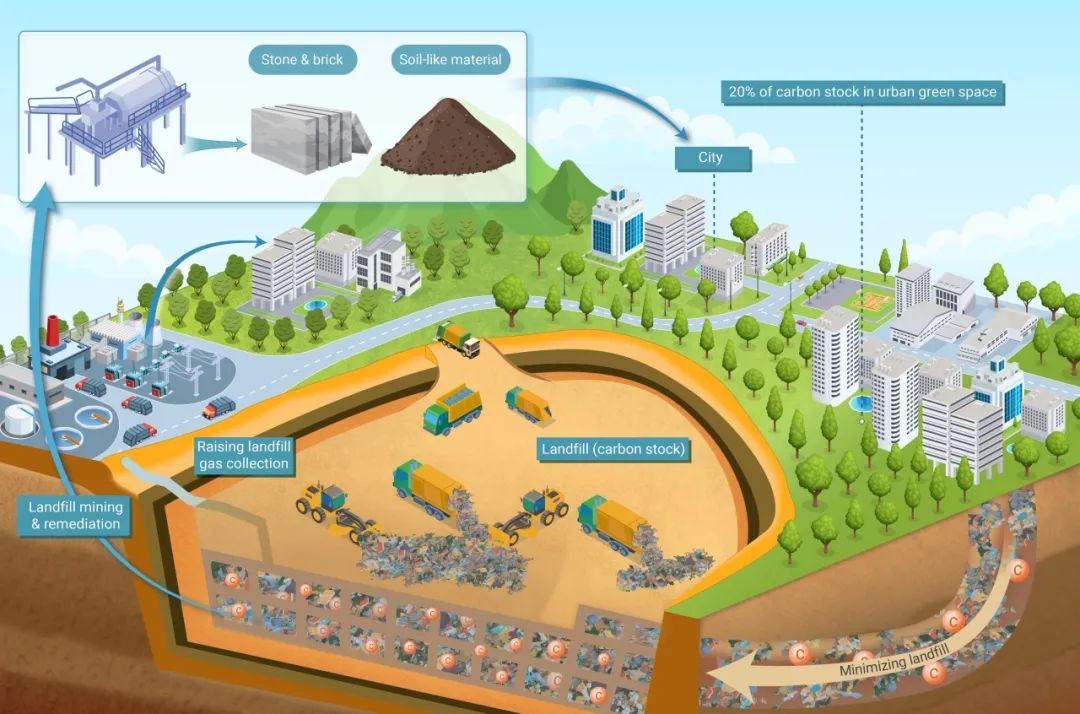
Fig.1 Abstract
1 | Temporal and spatial changes of organic carbon stocks in landfills
Over the past 20 years, the cumulative input of organic carbon and fossil carbon to landfills in China has reached 540 million tons, of which 76 percent went to sanitary landfills and 24 percent went to simple landfills.Of these carbon inputs, about 6.4% were released into the atmosphere as landfill gas (such as methane and carbon dioxide), about 0.3% entered water treatment systems or the water environment, and the remaining 93.3% were stored in landfills as carbon stocks. It was mainly in the form of humus soil (55%), plastics and rubber (31%), textiles (3.6%), and waste wood and bamboo (3.4%) (Fig.2).
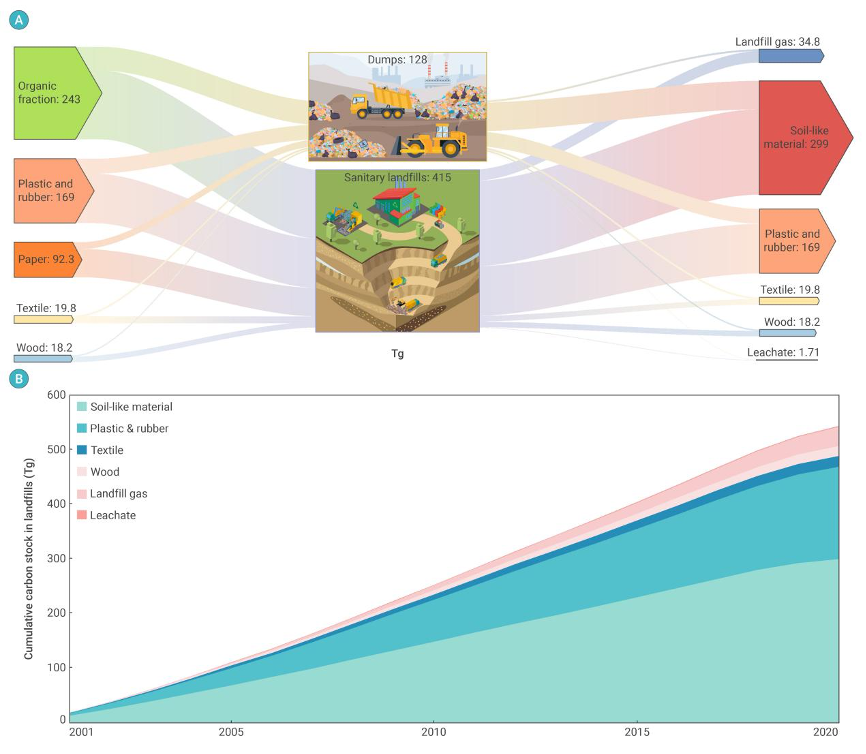
Fig.2 Cumulative organic carbon stocks of landfills in China (2001-2020)
From 2001 to 2020, the cumulative carbon stock in landfills rose from 18 million tons to 506 million tons per year, an increase of nearly 28.8 times. The disposal volume of simple landfill gradually decreased after reaching the peak in 2012, and the disposal volume of sanitary landfill showed a linear growth trend.The spatial distribution characteristics of urban solid waste landfills in China were basically consistent with "Hu Huanyong line". The carbon storage of landfills in cities east of the Hu Huanyong Line was significantly higher than that in the western region, which is 410 million tons and 90 million tons respectively. The landfill carbon storage of 31 provincial capitals in China accounted for 36.2% of the national total, of which the four economically developed cities in Beijing, Shanghai, Guangzhou and Shenzhen accounted for 12.7% of the total (Fig.3).

Fig.3 Spatial distribution of accumulated organic carbon stocks in landfills in China
2 | Resource and environmental effects of organic carbon storage in landfills
This paper proposes three indicators to evaluate the resource-environmental effects of carbon resource stocks in landfill, including the utilization potential of organic carbon in humus soil, the energy utilization potential of fossil carbon, and the contribution of urban methane emissions (Fig.4).
First, humus soil rich in organic carbon in landfills can be used as soil amendments for urban greening. The organic carbon stock of urban landfill accounts for 20% of the organic carbon stock of urban green land in China (the interquartile range is 9%-24%), and the highest is 39% in Northeast China, mainly because of low temperature and slow degradation of organic carbon.
Secondly, the combustible fossil carbon components in landfills (such as plastics, rubber, textiles and wood) have great potential for energy utilization. More than 81.5% of cities could meet their residents' electricity needs for more than one year by converting landfill fossil carbon stocks, and some cities in the northeast and Northwest of China could meet their electricity needs for up to four years.
Finally, landfill carbon stocks will result in continued methane emissions. Landfill emissions contribute 3.9% of the city's total methane emissions. In southern China, where temperature, humidity and kitchen waste production are high, landfills can even contribute about 60% of urban methane emissions.
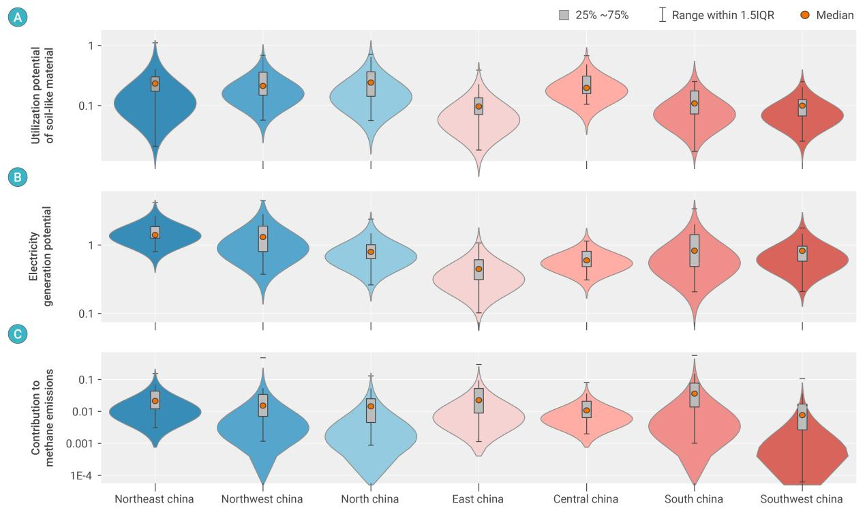
Fig.4. Resource and environmental effects of organic carbon stocks in landfills in different geographical regions of China
3 | Scenario analysis of carbon storage and carbon emission reduction in domestic waste landfill
In order to explore the change of carbon stock and the effect of carbon emission reduction in landfills, the main forms of carbon stock and their environmental effects, based on the difficulty of carbon resource utilization in landfills and the implementation of carbon emission reduction measures, four scenarios were set up in this study: "current situation scenario", "scenario of increasing methane collection rate", "scenario of minimizing landfill", and "scenario of landfill rehabilitation and management". Under the "current situation scenario" and "scenario of increasing methane collection rate", landfill carbon stocks reach 615 million tonnes in 2025 and 727 million tonnes in 2030, an increase of 16.9% and 38.2%, respectively. Under the "scenario of minimizing landfill" , by implementing the targets of the 14th Five-Year Plan (such as reducing the landfilling rate to 12% and increasing the proportion of waste incineration and biological treatment), the growth of carbon stocks in landfills would be significantly slowed, increasing by only 2.2% per year (Fig.5).
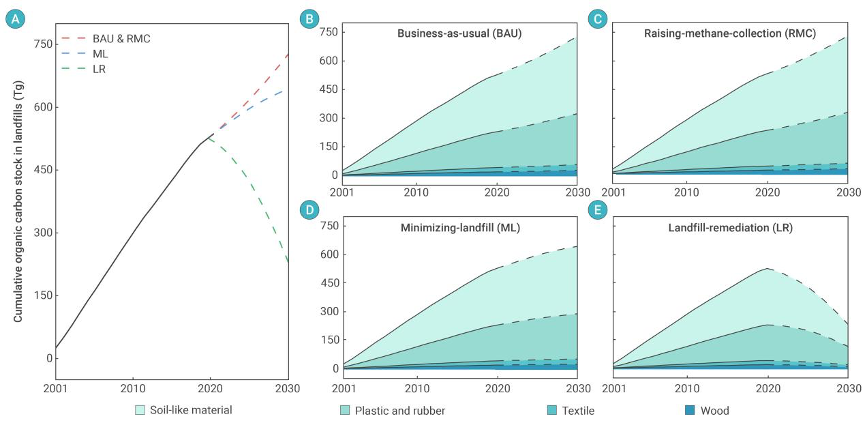
Fig.5 Scenario analysis of accumulated organic carbon stocks in landfills in China (2001-2030)
The "scenario of landfill rehabilitation and management" is the only one that makes a "carbon negative transition" possible. Through technical means such as aerobic stabilization, landfill mining and storage resource utilization, taking into account methane emission reduction and the "carbon footprint" of resource utilization, it is expected that by 2030 landfill carbon emissions can be reduced to -57 million tons of CO2eq/ year. The carbon reduction effect is mainly achieved through the energy conversion of fossil carbon such as plastic, rubber, textile and wood, and the replacement of fertilizer by the resource conversion of humus soil (Fig.6).
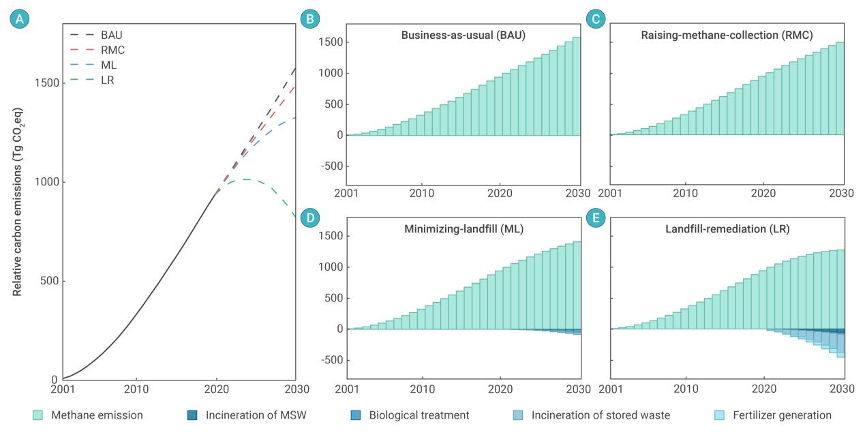
Fig.6 Scenario analysis of cumulative greenhouse gas emissions from landfills in China (2001-2030)
This paper further studies the economic feasibility of obtaining the above carbon reduction benefits. The total cost of the restoration and treatment of domestic waste landfill in China is estimated to be about 500 billion yuan, but it can also bring potential benefits such as electricity and fertilizer, and the net cost is estimated to be about 130 billion yuan (Fig.7). In addition, taking into account potential gains such as land reclamation and land price appreciation around landfills, landfill rehabilitation and management is an economically viable "negative carbon transition" model.

Fig.7 Cost-benefit analysis of landfill rehabilitation and management scenarios
4 | Summary and prospect
Through policy intervention and technological innovation, it is entirely possible for domestic waste landfills to realize the "negative carbon" transformation, and bring double benefits to the environment and economy. China's domestic waste landfill rehabilitation and management still need technological innovation and investment and financing model innovation. it is recommended to promote the development of landfill rehabilitation and management carbon emission reduction standards, to use carbon markets and other financial means to further promote the landfill "negative carbon" transformation, helping the city to achieve the "double carbon" goal.
source:https://mp.weixin.qq.com/s/556L99hVAdQJrKSNk6w1QA
